How to use a Marine VHF Radio!
Once you have completed the SRC (Short Range Certificate) course and have purchased your marine VHF radio, the next thing is to get comfortable with how to use it. This will make you confident in contacting other boat owners and marinas as well as being able to contact the emergency services should you need to. In fact, the more you are familiar with the features, the more confident you will become, using your VHF naturally without thinking about it.
Marine VHF Radio – Set-Up
When setting up your radio before use, make sure you TAG your favourite channels and become accustomed to using the scan function. If monitoring a second channel, you can also use the dual or tri watch feature to listen to 16 and another channel / channels. This function will automatically switch between whichever of these channels is active and revert to searching afterwards.
Marine VHF radios have two power settings: low and high (generally 1 & 5 watts). Always use low power as your default setting. Its shorter range means that other boats can use the same channel a few miles away without interfering with your call. CH16 always selects high power by default and channels 15 and 17 as adjacent channels, always select low power.
Make sure to test the squelch control on your radio. This function adjusts the sensitivity of your radio for better reception. Make sure it is set just at the point where it cancels out the static noise but not so far up that it prevents you from hearing other radio traffic. More information about all this is available in the manual of your Icom radio.
Marine Radio Procedure & Etiquette
If you live near a busy shipping or sailing area you may encounter a lot of commercial marine radio traffic. You will need to be brief, clear and disciplined when operating your radio. There are only a few ship-to-ship channels (6, 8, 72 & 77) and they will become congested if unnecessary broadcasts are made.
Listen on the calling Channel 16 for at least 30 seconds to ensure you will not interfere with a conversation already in progress. If the channel is clear, press the Push-to-Talk button on your microphone and follow the protocol that you learned on your
SRC radio course. It is important to have a good microphone technique to convey your message clearly. Hold the microphone one inch from your mouth, and clearly call the name of the other vessel in a normal tone of voice so that you avoid any distortion. Make sure you identify yourself, not only is it a condition of your licence but also avoids confusion for those receiving your transmission.
Make sure you keep chatter away from safety Channel 16. Channel 16 is the ‘Distress and Calling’ channel, everyone can use this channel to contact others but remember that all ‘Mayday’ and ‘Pan-Pan’ calls are also dealt with here so it must be kept free and available for such emergencies. It is much better to use the DSC function to make an individual call.
When calling a marina on UK Marina Channel 80, remember it is a Duplex channel, you can only hear the marina talking to a skipper, you can’t hear a skipper talking to the marina. So listen for a short period to make sure the marina is not already conversing with another boatowner.
If you are speaking on an open deck, shield the mic from the wind. Likewise, you may hold the remote mic to your ear when listening in windy conditions when on a open boat like a RIB. If water has entered the microphone, remember to shake it first or use the
Aquaquake function to clear it before speaking otherwise your transmission maybe muffled and distorted!
If you follow this advice, you will have a successful and confident time using your marine VHF radio at sea…happy boating!

